Dew Yield and Its Influencing Factors at the Western Edge of Gurbantunggut Desert, China
Abstract
:1. Introduction
2. Materials and Methods
2.1. Measurement Site
2.2. LWS Calibration
2.3. Experimental Design
2.4. Data Processing
2.4.1. Dew Yield, Intensity and Frequency
2.4.2. Dewpoint Temperature
2.4.3. Cloud Cover
2.4.4. Wind Speed
2.4.5. Statistical Analysis
3. Results
3.1. Daily Variation of Dew
3.2. Annual Variation of Dew
3.3. Dew versus Rain
3.3.1. Daily Rainfall
3.3.2. Dew Days
3.3.3. Dew Yield
3.4. Influence Factors
3.4.1. Correlation Analysis on Single Factor
3.4.2. Multiple Regression Analysis
4. Discussion
5. Conclusions
Author Contributions
Funding
Acknowledgments
Conflicts of Interest
References
- Kidron, G.J. Analysis of dew precipitation in three habitats within a small arid drainage basin, Negev Highlands, Israel. Atmos. Res. 2000, 55, 257–270. [Google Scholar] [CrossRef]
- Beysens, D. Dew Water; River Publishers Series in Chemical, Environmental, and Energy Engineering; River Publishers: Gistrup, Denmark; Delft, The Netherlands, 2018. [Google Scholar]
- Tomaszkiewicz, M.; Abou Najm, M.; Beysens, D.; Alameddine, I.; El-Fadel, M. Dew as a Sustainable Non-Conventional Water Resource: A Critical Review. Environ. Rev. 2015, 23, 425–442. [Google Scholar] [CrossRef]
- Kidron, G.J.; Herrnstadt, I.; Barzilay, E. The role of dew as a moisture source for sand microbiotic crusts in the Negev Desert, Israel. J. Arid Environ. 2002, 52, 517–533. [Google Scholar] [CrossRef]
- Rao, B.Q.; Liu, Y.D.; Wang, W.B.; Hu, C.X.; Li, D.H.; Lan, S.B. Influence of dew on biomass and photosystem II activity of cyanobacterial crusts in the Hopq Desert, northwest China. Soil Biol. Biochem. 2009, 41, 2387–2393. [Google Scholar] [CrossRef]
- Pan, Y.X.; Wang, X.P.; Zhang, Y.F.; Hu, R. Dew formation characteristics at annual and daily scale in xerophyte shrub plantations at Southeast margin of Tengger desert, Northern China. Ecohydrology 2018, 11, e1968. [Google Scholar] [CrossRef]
- Zhang, J.; Zhang, Y.M.; Downing, A.; Cheng, J.H.; Zhou, X.B.; Zhang, B.C. The influence of biological soil crusts on dew deposition in Gurbantunggut Desert, Northwestern China. J. Hydrol. 2009, 379, 220–228. [Google Scholar] [CrossRef]
- Kidron, G.J.; Temina, M. The effect of dew and fog on lithic lichens along an altitudinal gradient in the Negev Desert. Geomicrobiol. J. 2013, 30, 281–290. [Google Scholar] [CrossRef]
- Pan, Y.X.; Wang, X.P. Effects of shrub species and microhabitats on dew formation in a revegetation-stabilized desert ecosystem in Shapotou, northern China. J. Arid Land 2014, 6, 389–399. [Google Scholar] [CrossRef]
- Steinberger, Y.; Loboda, I.; Garner, W. The influence of autumn dewfall on spatial and temporal distribution of nematodes in the desert ecosystem. J. Arid Environ. 1989, 16, 177–183. [Google Scholar] [CrossRef]
- Agam, N.; Berliner, P.R. Dew formation and water vapor adsorption in semi-arid environments—A review. J. Arid Environ. 2006, 65, 572–590. [Google Scholar] [CrossRef]
- Groh, J.; Slawitschika, V.; Herndl, M.; Graf, A.; Vereecken, H.; Pütz, T. Determining dew and hoar frost formation for a low mountain range and alpine grassland site by weighable lysimeter. J. Hydrol. 2018, 563, 372–381. [Google Scholar] [CrossRef]
- Wen, X.F.; Lee, X.H.; Sun, X.M.; Wang, J.L.; Hu, Z.M.; Li, S.G.; Yu, J.R. Dew water isotopic ratios and their relationships to ecosystem water pools and fluxes in a cropland and a grassland in China. Oecologia 2012, 168, 549–561. [Google Scholar] [CrossRef]
- Richards, K. Observation and simulation of dew in rural and urban environments. Prog. Phys. Geogr. 2004, 28, 76–94. [Google Scholar] [CrossRef]
- Saito, H.; Simunek, J.; Scanlon, B.R.; Reedy, R.C. Numerical Analysis of Coupled Water, Vapor, and Heat Transport in the Vadose Zone. Vadose Zone J. 2006, 5, 784–800. [Google Scholar] [CrossRef]
- Monteith, J.L.; Unsworth, M. Principles of Environmental Physics, 2nd ed.; Edward Arnold: London, UK, 1990; p. 291. [Google Scholar]
- Pan, Y.X.; Wang, X.P.; Zhang, Y.F. Dew formation characteristics in a revegetation-stabilized desert ecosystem in Shapotou area, Northern China. J. Hydrol. 2010, 387, 265–272. [Google Scholar] [CrossRef]
- Ye, Y.H.; Zhou, K.; Song, L.Y.; Jin, J.H.; Peng, S.L. Dew amounts and its correlations with meteorological factors in urban landscapes of Guangzhou, China. Atmos. Res. 2007, 86, 21–29. [Google Scholar] [CrossRef]
- Beysens, D. The formation of dew. Atmos. Res. 1995, 39, 215–237. [Google Scholar] [CrossRef]
- Li, X.Y. Effects of gravel and sand mulches on dew deposition in the semiarid region of China. J. Hydrol. 2002, 260, 151–160. [Google Scholar] [CrossRef]
- Zhang, X.; Li, X.; Wang, W. Experimental Observation Analysis on Dew Formation in Southern Mu us Sandy Land. Arid Meteorol. 2008, 26, 8–13. [Google Scholar]
- Ritter, F.; Berkelhammer, M.; Beysens, D. Dew frequency across the US from a network of in situ radiometers. Hydrol. Earth Syst. Sci. Eur. Geosci. Union 2019, 23, 1179–1197. [Google Scholar] [CrossRef]
- Duvdevani, S. An optical method of dew estimation. Q. J. R. Meteorol. Soc. 1947, 73, 282–296. [Google Scholar] [CrossRef]
- Davis, D.R.; Hughes, J.E. A new approach to recording the wetting parameter by the use of electrical resistance sensors. Plant Dis. Rep. 1970, 54, 474–479. [Google Scholar]
- Zangvil, A. Six years of dew observations in the Negev Desert, Israel. J. Arid Environ. 1996, 32, 361–371. [Google Scholar] [CrossRef]
- Moro, M.J.; Were, A.; Villagarcía, L.; Canto´n, Y.; Domingo, F. Dew measurement by Eddy covariance and wetness sensor in a semiarid ecosystem of SE Spain. J. Hydrol. 2007, 335, 295–302. [Google Scholar] [CrossRef]
- Sentelhas, P.C.; Marta, A.D.; Orlandini, S. Suitability of relative humidity as an estimator of leaf wetness duration. Agric. For. Meteorol. 2008, 148, 392–400. [Google Scholar] [CrossRef]
- Kabela, E.D.; Hornbuckle, B.K.; Cosh, M.H.; Anderson, M.C.; Gleason, M.L. Dew frequency, duration, amount, and distribution in corn and soybean during SMEX05. Agric. For. Meteorol. 2009, 149, 11–24. [Google Scholar] [CrossRef]
- Wang, X.; Gao, Z.Y.; Wang, Y.K.; Wang, Z.; Jin, S. Dew measurement and estimation of rain-fed jujube (Zizyphus jujube Mill) in a semi-arid loess hilly region of China. J. Arid Land 2017, 9, 547–557. [Google Scholar] [CrossRef]
- Jia, Z.F.; Wang, Z.; Wang, H. Characteristics of Dew Formation in the Semi-Arid Loess Plateau of Central Shaanxi Province, China. Water 2019, 11, 126. [Google Scholar] [CrossRef]
- Muselli, M.; Beysens, D.; Mileta, M.; Milimouk, I. Dew and rain water collection in the Dalmatian Coast, Croatia. Atmos. Res. 2009, 92, 455–463. [Google Scholar] [CrossRef]
- Lekouch, I.; Lekouch, K.; Muselli, M.; Mongruel, A.; Kabbachi, B.; Beysens, D. Rooftop dew, fog and rain collection in southwest Morocco and predictive dew modeling using neural networks. J. Hydrol. 2012, 448–449, 60–72. [Google Scholar] [CrossRef]
- Beysens, D.; Milimouk, I.; Nikolayev, V.; Muselli, M.; Marcillat, J. Using radiative cooling to condense atmospheric vapour: A study to improve water yield. J. Hydrol. 2003, 276, 1–11. [Google Scholar] [CrossRef]
- Beysens, D.; Pruvost, V.; Pruvost, B. Dew observed on cars as a proxy for quantitative measurements. J. Arid Environ. 2016, 135, 90–95. [Google Scholar] [CrossRef]
- Zhang, Q.; Wang, S.; Yang, F.; Yue, P.; Yao, T.; Wang, W.Y. Characteristics of Dew Formation and Distribution, and Its Contribution to the Surface Water Budget in a Semi-arid Region in China. Bound. Layer Meteorol. 2015, 154, 317–331. [Google Scholar] [CrossRef]
- Kidron, G.J.; Kronenfeld, R. Assessing the effect of micro-lysimeters on NRWI: Do micro-lysimeters adequately represent the water input of natural soil? J. Hydrol. 2017, 548, 382–390. [Google Scholar] [CrossRef]
- Meissner, R.; Seeger, J.; Rupp, H.; Seyfarth, M.; Borg, H. Measurement of dew, fog, and rime with a high-precision gravitation lysimeter. J. Plant Nutr. Soil Sci. 2007, 170, 335–344. [Google Scholar] [CrossRef]
- Ucles, O.; Villagarcia, L.; Moro, M.J.; Canton, Y.; Domingo, F. Role of dewfall in the water balance of a semiarid coastal steppe ecosystem. Hydrol. Process. 2014, 28, 2271–2280. [Google Scholar] [CrossRef]
- Gao, Z.; Wang, Y.; Wang, X. Dew Amount of Jujube Plantation in Semi-arid Loess Hilly-gully Region. Trans. Chin. Soc. Agric. Mach. 2015, 46, 105–115. (In Chinese) [Google Scholar]
- Beysens, D. Estimating dew yield worldwide from a few meteo data. Atmos. Res. 2016, 167, 146–155. [Google Scholar] [CrossRef]
- Fan, L.L.; Tang, L.S.; Wu, L.F.; Ma, J.; Li, Y. The limited role of snow water in the growth and development of ephemeral plants in a cold desert. J. Veg. Sci. 2014, 25, 681–690. [Google Scholar] [CrossRef]
- Tiemuerbieke, B.; Min, X.J.; Zang, Y.X.; Xing, P.; Ma, J.Y.; Sun, W. Water use patterns of co-occurring C3, and C4, shrubs in the Gurbantonggut desert in northwestern China. Sci. Total Environ. 2018, 634, 341–354. [Google Scholar] [CrossRef]
- Zhao, R.; Hui, R.; Liu, L.; Xie, M.; An, L.Z. Effects of snowfall depth on soil physical–chemical properties and soil microbial biomass in moss–dominated crusts in the Gurbantunggut Desert, Northern China. Catena 2018, 169, 175–182. [Google Scholar] [CrossRef]
- Zhou, X.B.; Zhang, Y.M.; Yin, B.F. Divergence in physiological responses between cyanobacterial and lichen crusts to a gradient of simulated nitrogen deposition. Plant Soil 2016, 399, 121–134. [Google Scholar] [CrossRef]
- Decagon Devices, Inc. Dielectric Leaf Wetness Sensor Operator’s Manual Version 3; Decagon Devices, Inc.: Pullman, WA, USA, 2007–2010. [Google Scholar]
- Kidron, G.J. The effect of substrate properties, size, position, sheltering and shading on dew: An experimental approach in the Negev Desert. Atmos. Res. 2010, 98, 378–386. [Google Scholar] [CrossRef]
- Lawrence, M.G. The relationship between relative humidity and the dewpoint temperature in moist air. Am. Meteorol. Soc. 2005, 86, 225–233. [Google Scholar] [CrossRef]
- Alduchov, O.A.; Eskridge, R.E. Improved Magnus form approximation of saturation vapor pressure. J. Appl. Meteorol. 1996, 35, 601–609. [Google Scholar] [CrossRef]
- Beysens, D.; Muselli, M.; Nikolayev, V.; Narhe, R.; Milimouk, I. Measurement and modelling of dew in island, coastal and alpine areas. Atmos. Res. 2005, 73, 1–22. [Google Scholar] [CrossRef]
- Jacobs, A.F.G.; Heusinkveld, B.G.; Kruit, R.J.W.; Berkowicz, S.M. Contribution of dew to the water budget of a grassland area in the Netherlands. Water Resour. Res. 2006, 42, 446–455. [Google Scholar] [CrossRef]
- Hanisch, S.; Lohrey, C.; Buerkert, A. Dewfall and its ecological significance in semi-arid coastal south-western Madagascar. J. Arid Environ. 2015, 121, 24–31. [Google Scholar] [CrossRef]
- Kappen, L.; Lange, O.L.; Schulze, E.D.; Evenari, M.; Buschbom, V. Ecophysiological investigations on lichens of the Negev Desert: IV. Annual course of the photosynthetic production of Ramalina maciformis (Del.) Bory. Flora 1979, 168, 85–105. [Google Scholar] [CrossRef]
- Long, Y.; Tan, D.Y.; Baskin, C.C.; Baskin, J.M. Seed dormancy and germination characteristics of Astragalus arpilobus (Fabaceae, subfamily Papilionoideae), a central Asian desert annual ephemeral. S. Afr. J. Bot. 2012, 83, 68–77. [Google Scholar] [CrossRef]
- Zhou, Y.M.; Lu, J.J.; Tan, D.Y.; Baskin, C.C.; Baskin, J.M. Seed germination ecology of the cold desert annual Isatis violascens (Brassicaceae): Two levels of physiological dormancy and role of the Pericarp. PLoS ONE 2015, 10, e0140983. [Google Scholar] [CrossRef]
- Chen, Y.; Zhang, L.; Shi, X.; Ban, Y.; Liu, H.; Zhang, D. Life history responses of spring-and autumn-germinated ephemeral plants to increased nitrogen and precipitation in the Gurbantunggut Desert. Sci. Total Environ. 2019, 659, 756–763. [Google Scholar] [CrossRef]
- Lu, J.J.; Tan, D.Y.; Baskin, C.C.; Baskin, J.M. Effects of germination season on life history traits and on transgenerational plasticity in seed dormancy in a cold desert annual. Sci. Rep. 2016, 6, 25076. [Google Scholar] [CrossRef]
- Clus, O.; Ortega, P.; Muselli, M.; Milimouk, I.; Beysens, D. Study of dew water collection in humid tropical islands. J. Hydrol. 2008, 361, 159–171. [Google Scholar] [CrossRef]
- Maestre-Valero, J.; Martinez-Alvarez, V.; Baille, A.; Martín-Górriz, B.; Gallego-Elvira, B. Comparative analysis of two polyethylene foil materials for dewharvesting in a semi-arid climate. J. Hydrol. 2011, 410, 84–91. [Google Scholar] [CrossRef]
- Sharan, G.; Beysens, D.; Milimouk-Melnytchouk, I. A study of dew water yields on Galvanized iron roofs in Kothara (North-West India). J. Arid Environ. 2007, 69, 259–269. [Google Scholar] [CrossRef]
- Monteith, J.L. Dew. Q. J. R. Meteorol. Soc. 1957, 83, 322–341. [Google Scholar] [CrossRef]
- Berger, X.; Bathiebo, J. Clear sky radiation as a function of altitude. Int. J. Renew. Energy 1992, 2, 139–157. [Google Scholar] [CrossRef]
- Hao, X.M.; Li, C.; Guo, B.; Ma, J.X.; Ayup, M.; Chen, Z.S. Dew formation and its long-term trend in a desert riparian forest ecosystem on the eastern edge of the Taklimakan Desert in China. J. Hydrol. 2012, 472–473, 90–98. [Google Scholar] [CrossRef]
- Garratt, J.R.; Segal, M. On the contribution to dew formation. Bound.-Layer Meteorol. 1988, 45, 209–236. [Google Scholar] [CrossRef]
- Xiao, H.; Meissner, R.; Borg, H.; Wang, R.; Cao, Q. Agreement of Four Equations for Computing Dewfall in Northern Germany. Water 2017, 9, 607. [Google Scholar] [CrossRef]
- Jacobs, A.F.G.; Heusinkveld, B.G.; Berkowicz, S.M. Passive dew collection in a grassland area, The Netherlands. Atmos. Res. 2008, 87, 377–385. [Google Scholar] [CrossRef]
- Maestre-Valero, J.F.; Ragab, R.; Martínez-Alvarez, V.; Baille, A. Estimation of dew yield from radiative condensers by means of an energy balance model. J. Hydrol. 2012, 460–461, 103–109. [Google Scholar] [CrossRef]
- Wang, H.; Sanchez-Molina, A.S.; Li, M.; Díaz, F.R. Improving the Performance of Vegetable Leaf Wetness Duration Models in Greenhouses Using Decision Tree Learning. Water 2019, 11, 158. [Google Scholar] [CrossRef]
- Subramaniam, A.R.; Kesava Rao, A.V.R. Dew fall in sand dune areas of India. Int. J. Biometeorol. 1983, 27, 271–280. [Google Scholar] [CrossRef]
- Yan, B.X.; Deng, W. Study on the dew resource in Sanjiang Plain. J. Nat. Resour. 2004, 19, 732–737. (In Chinese) [Google Scholar]
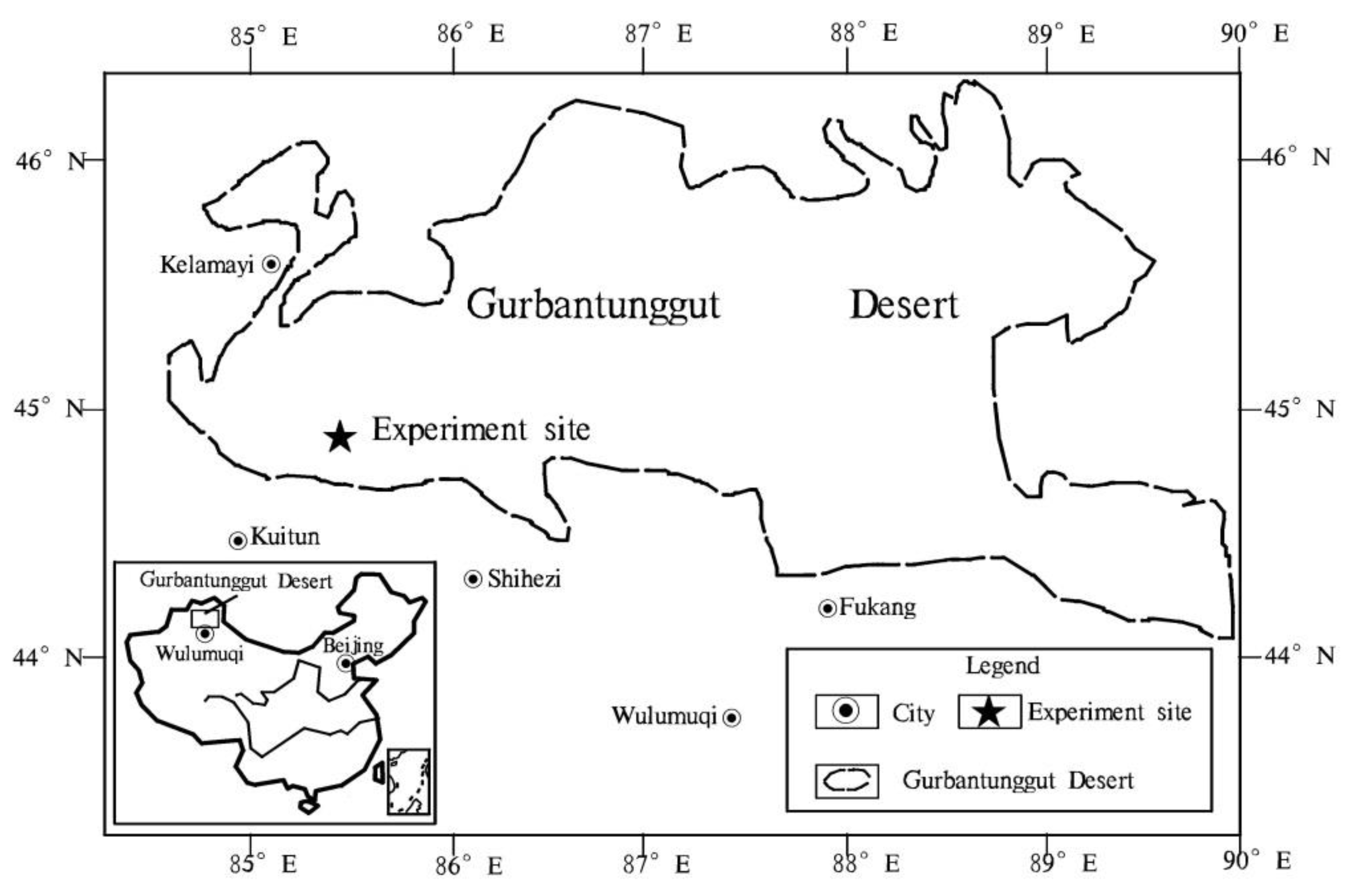
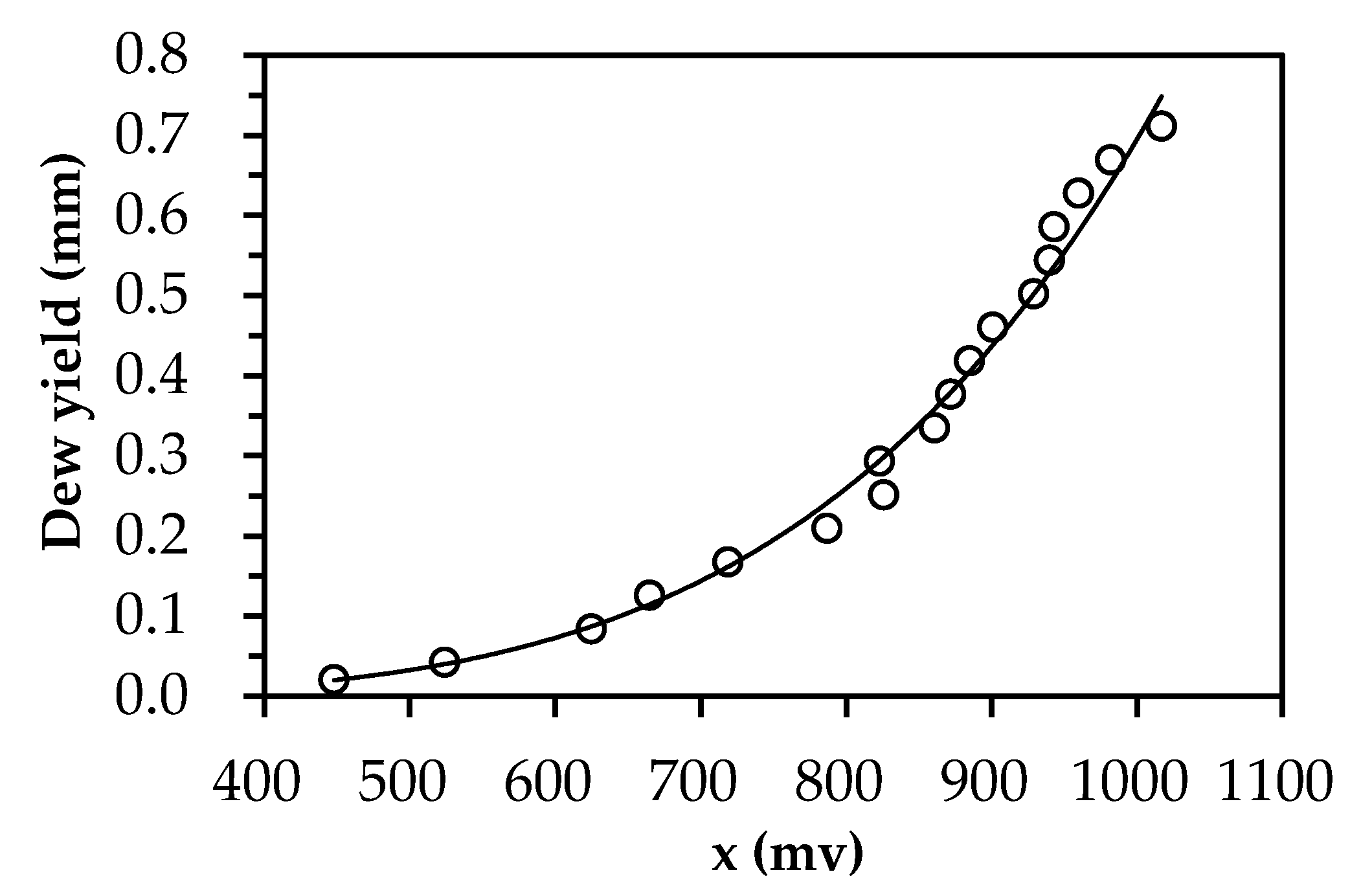
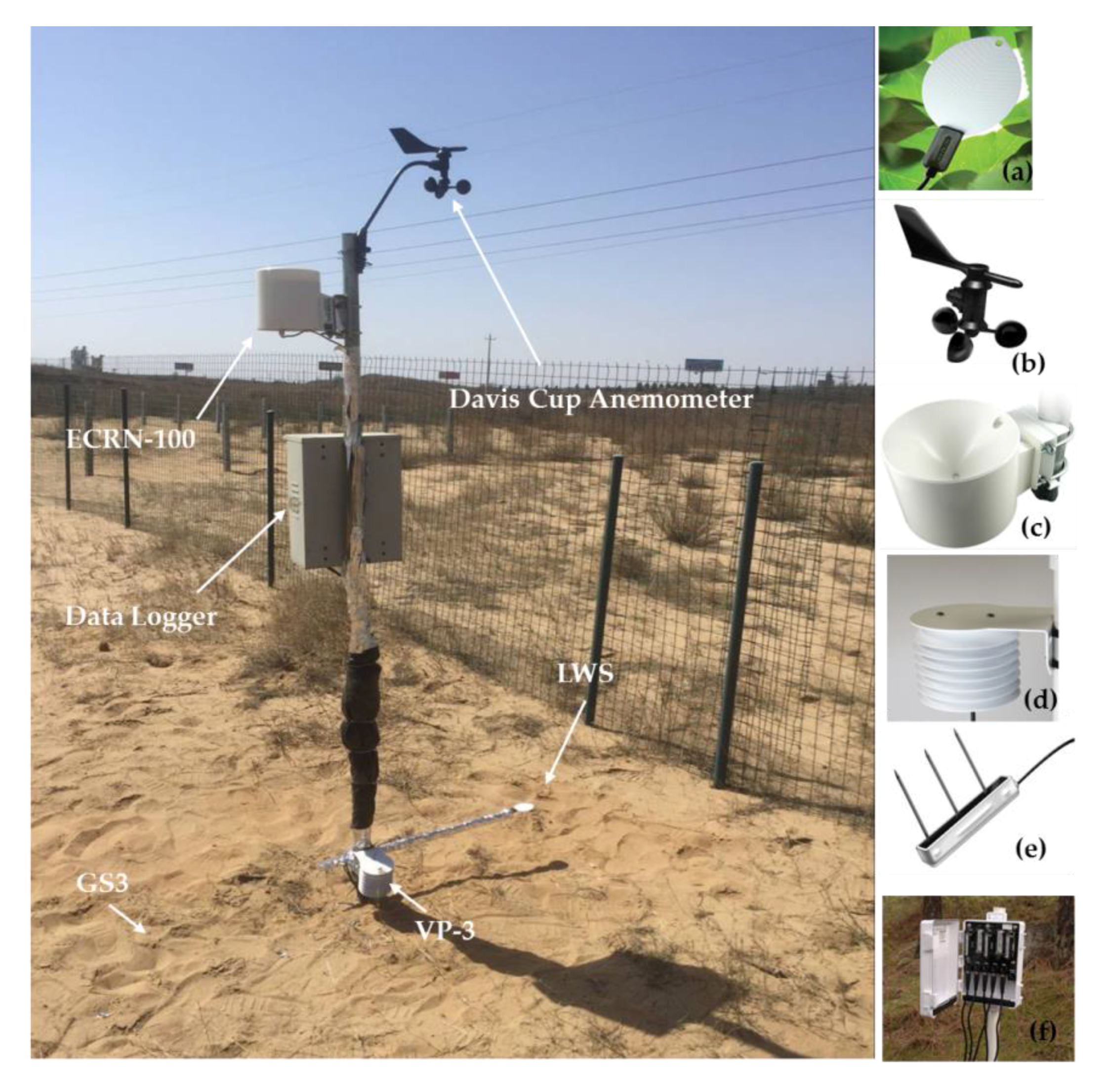
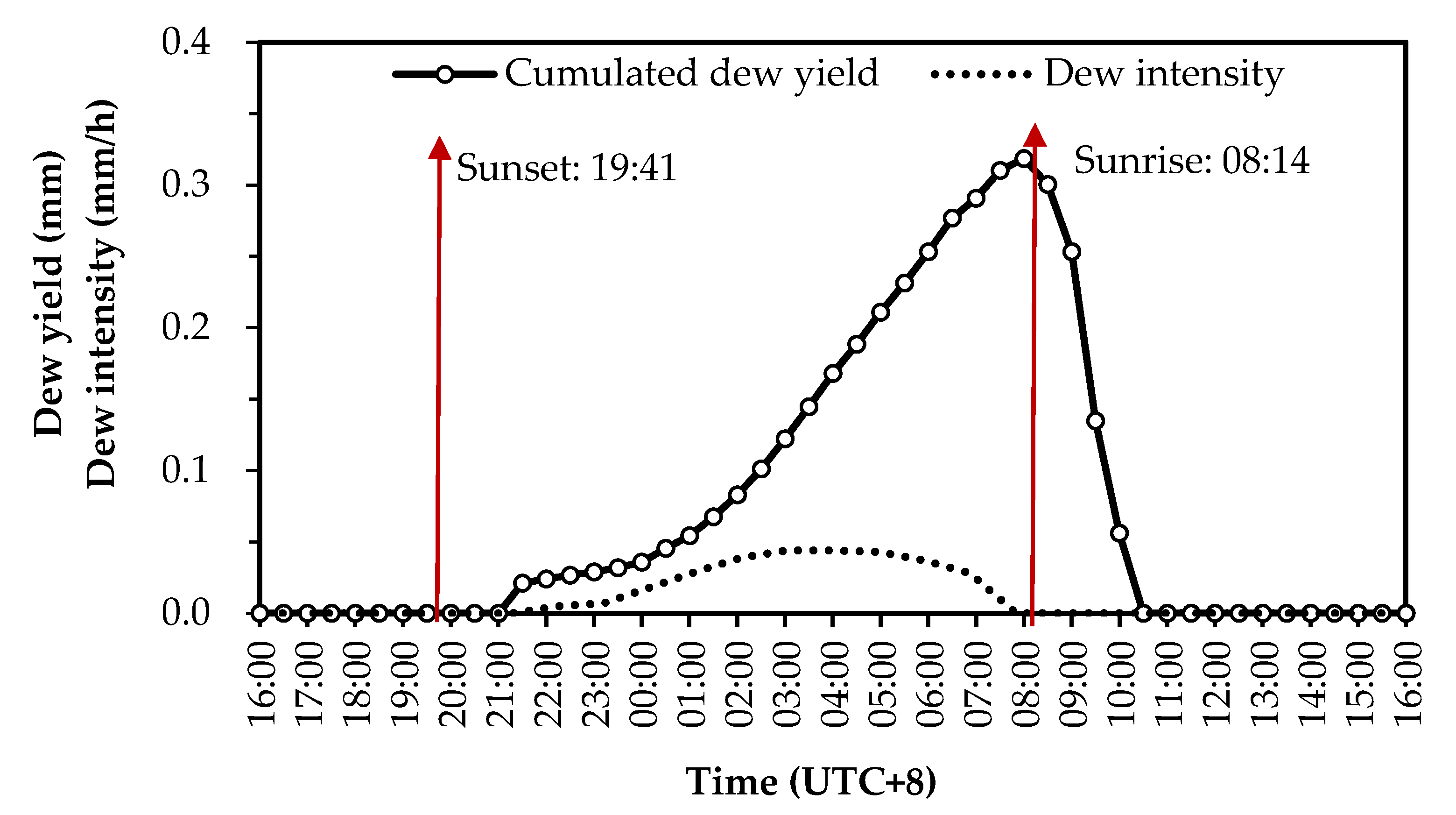
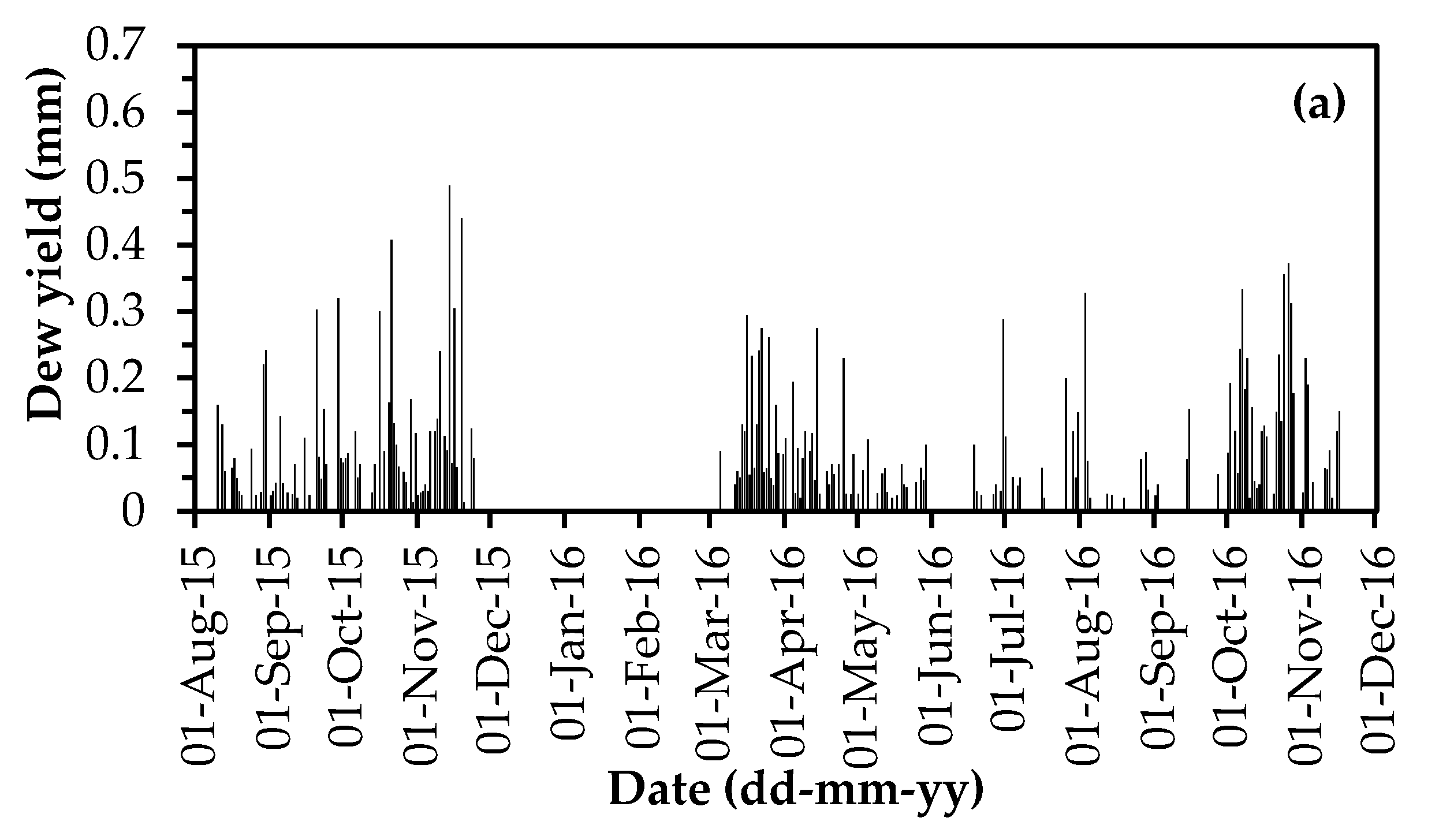
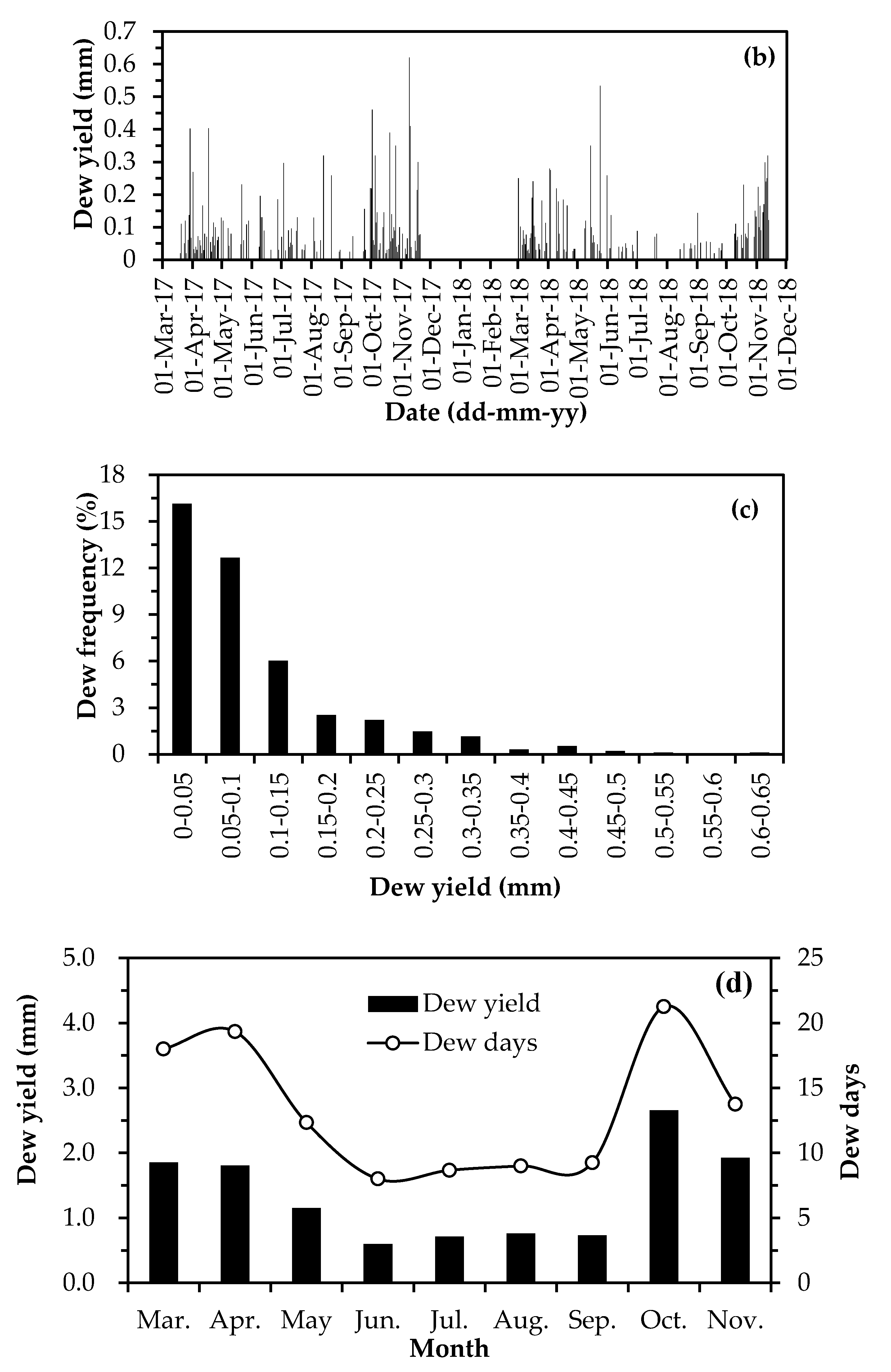
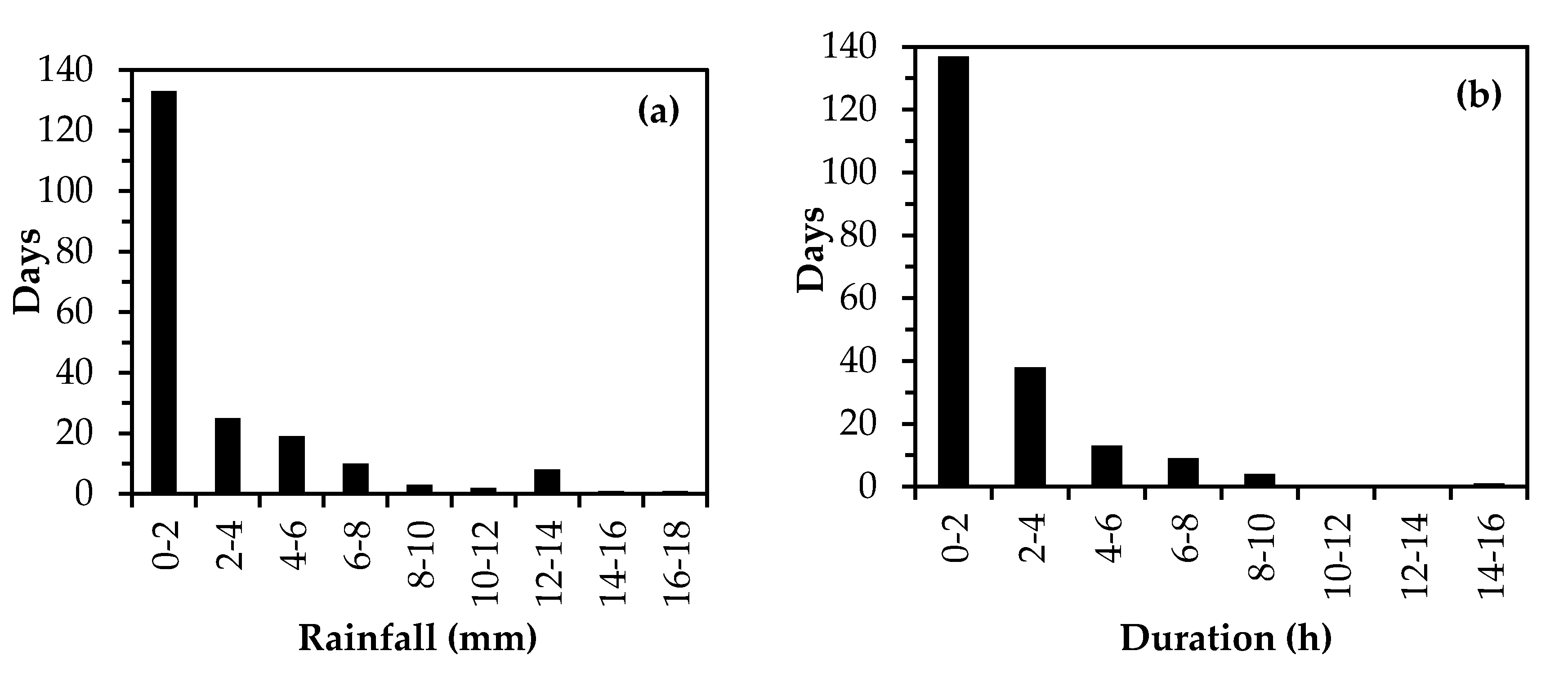
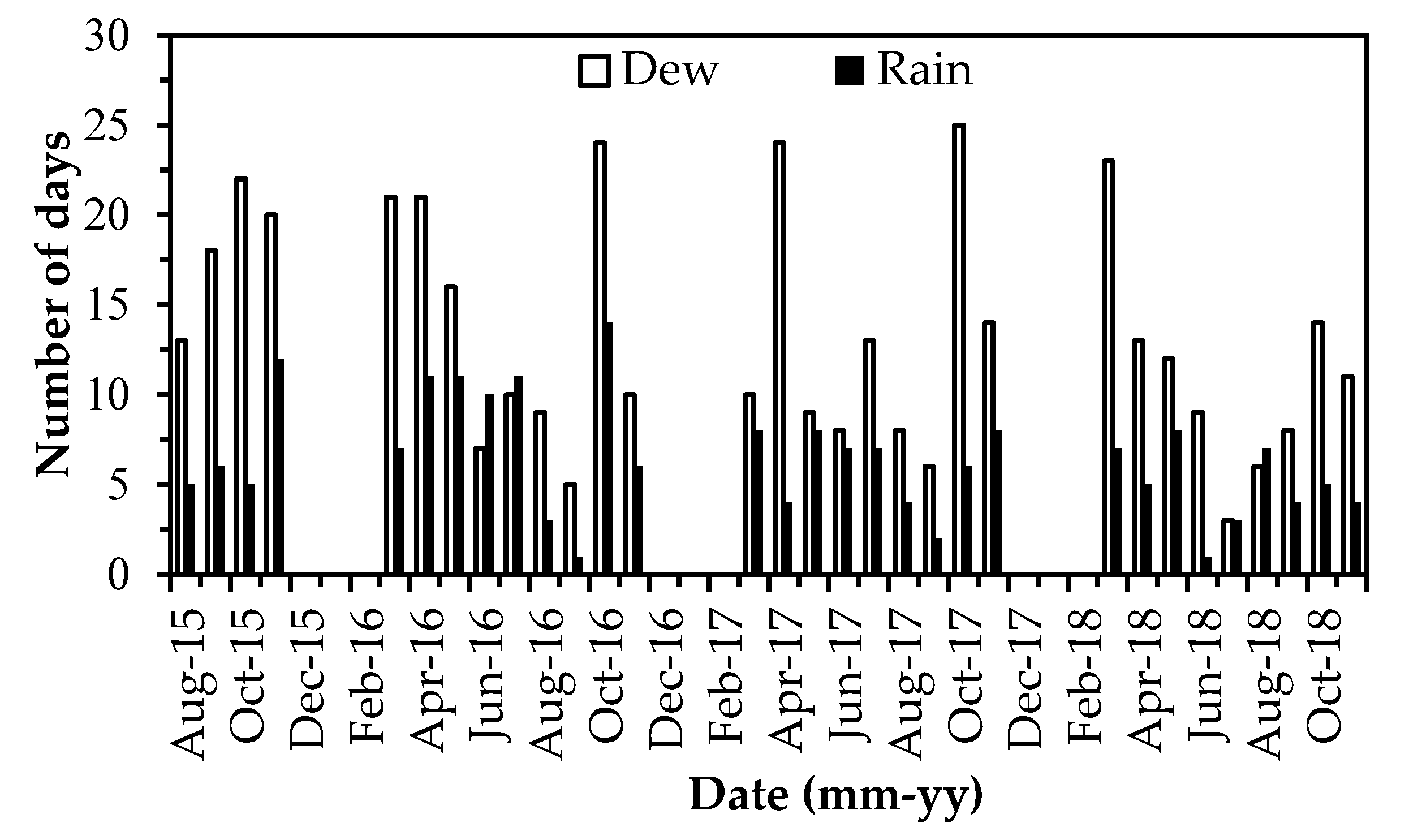
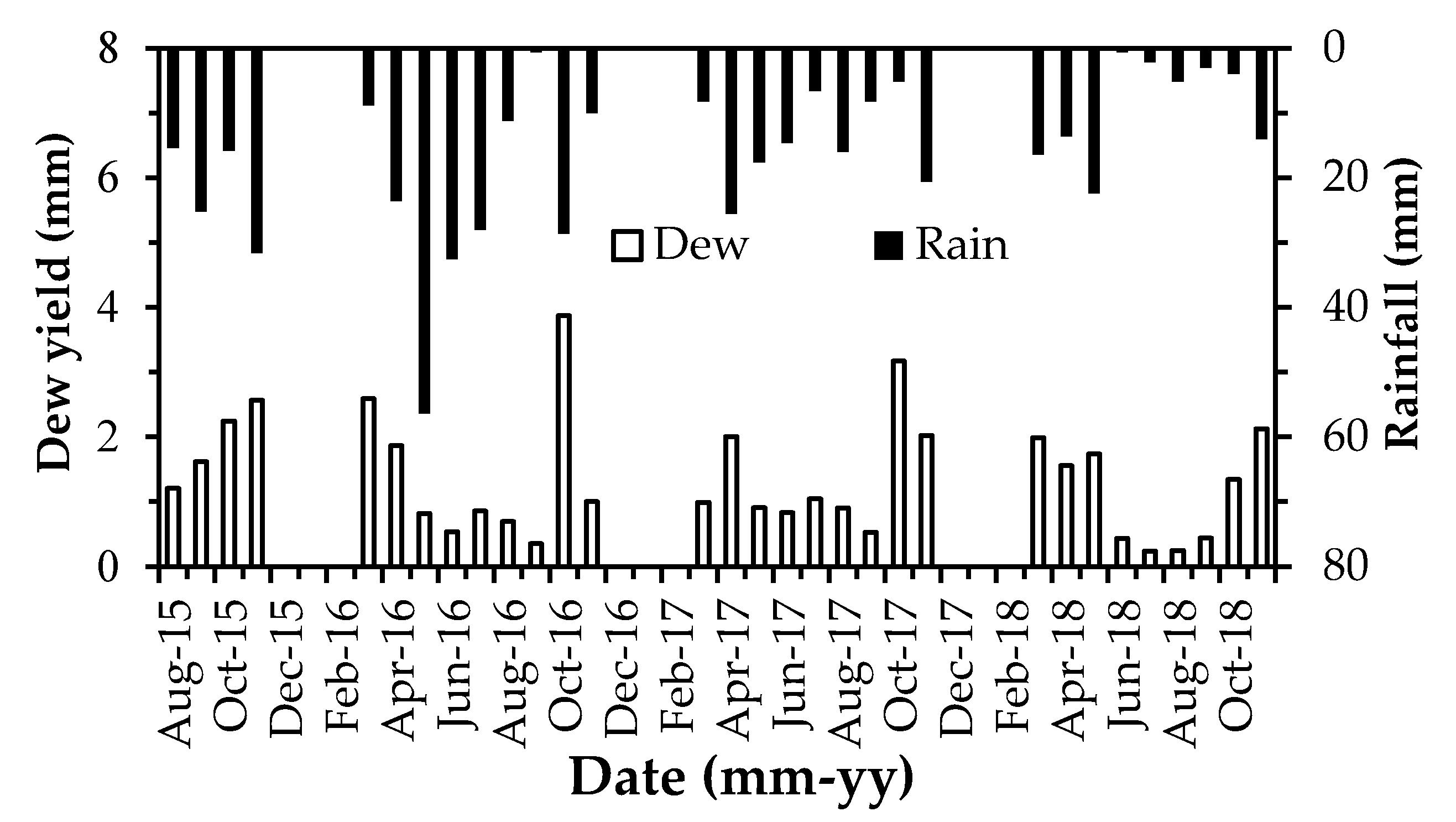
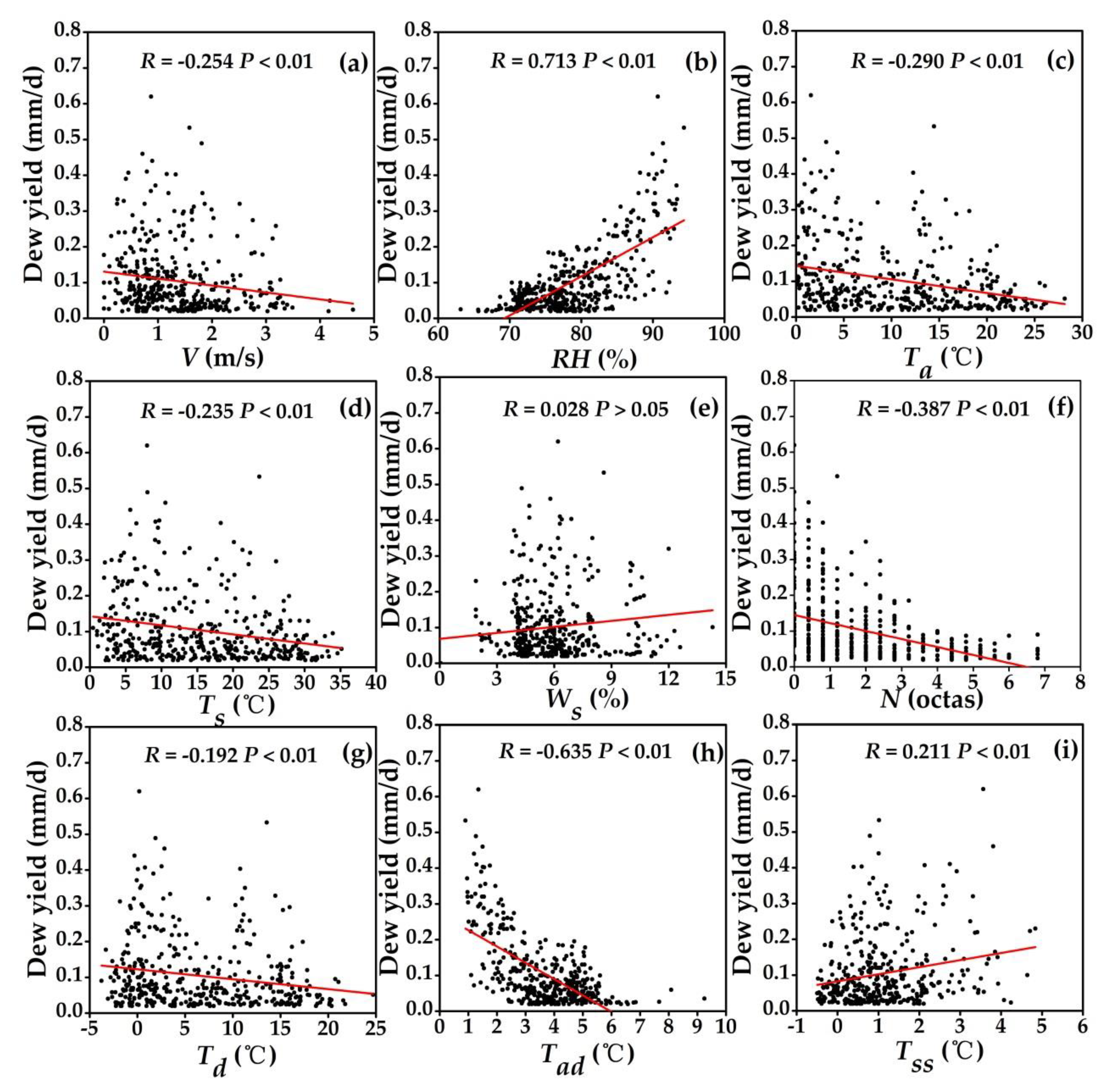
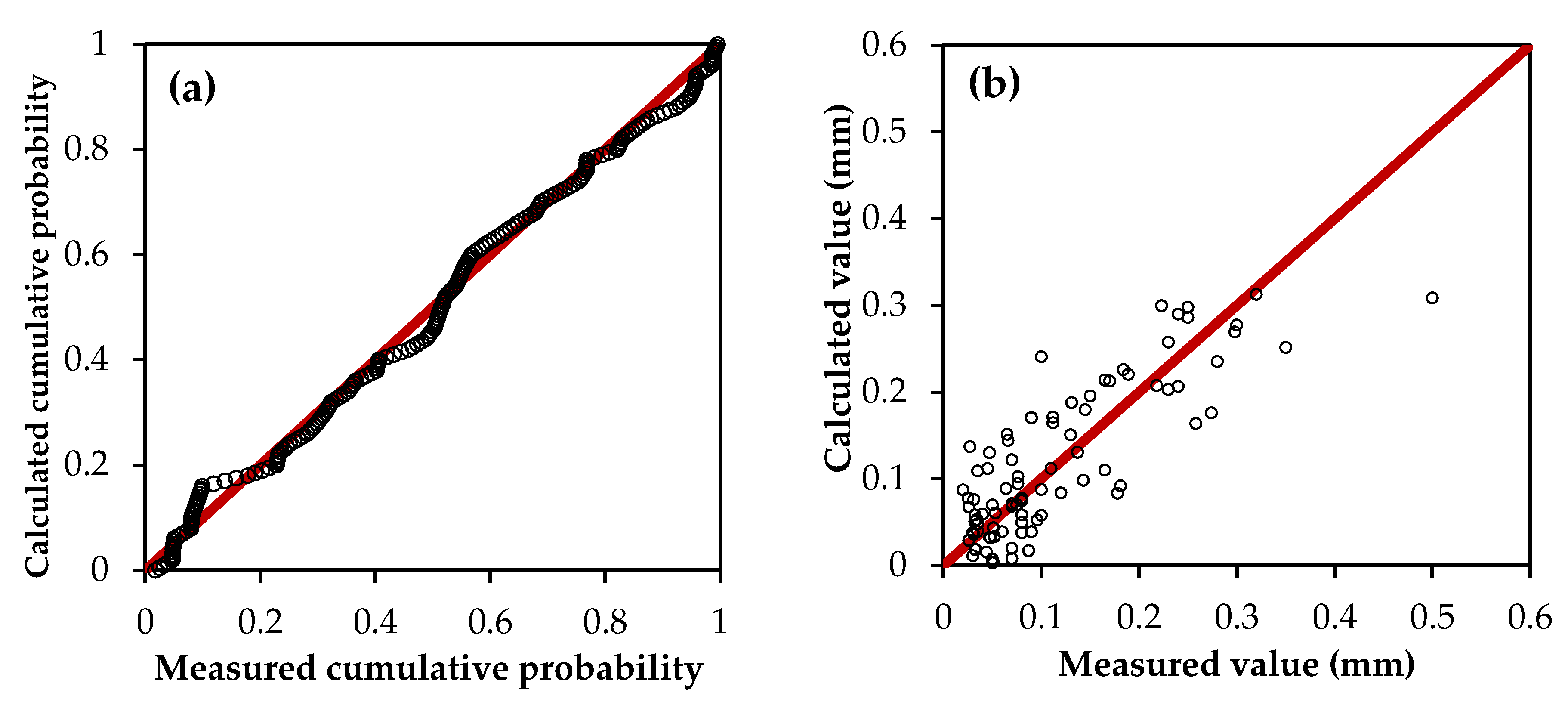
| Model | Variable | Unstandardized Coefficients | Significance | Tolerance | R Square | F Value | |
|---|---|---|---|---|---|---|---|
| B | Std. Error | ||||||
| 1 | Constant | −0.664 | 0.049 | 0.000 | 0.512 | 243.182 | |
| RH | 0.0096 | 0.001 | 0.000 | 1.000 | |||
| 2 | Constant | −0.729 | 0.048 | 0.000 | 0.598 | 158.228 | |
| RH | 0.011 | 0.001 | 0.000 | 0.713 | |||
| N | −0.007 | 0.003 | 0.001 | 0.713 | |||
| 3 | Constant | −0.705 | 0.051 | 0.000 | 0.642 | 82.987 | |
| RH | 0.011 | 0.001 | 0.000 | 0.704 | |||
| N | −0.006 | 0.003 | 0.001 | 0.703 | |||
| V | −0.010 | 0.005 | 0.008 | 0.943 | |||
© 2019 by the authors. Licensee MDPI, Basel, Switzerland. This article is an open access article distributed under the terms and conditions of the Creative Commons Attribution (CC BY) license (http://creativecommons.org/licenses/by/4.0/).
Share and Cite
Jia, Z.; Zhao, Z.; Zhang, Q.; Wu, W. Dew Yield and Its Influencing Factors at the Western Edge of Gurbantunggut Desert, China. Water 2019, 11, 733. https://doi.org/10.3390/w11040733
Jia Z, Zhao Z, Zhang Q, Wu W. Dew Yield and Its Influencing Factors at the Western Edge of Gurbantunggut Desert, China. Water. 2019; 11(4):733. https://doi.org/10.3390/w11040733
Chicago/Turabian StyleJia, Zhifeng, Zhiqiang Zhao, Qianyi Zhang, and Weichen Wu. 2019. "Dew Yield and Its Influencing Factors at the Western Edge of Gurbantunggut Desert, China" Water 11, no. 4: 733. https://doi.org/10.3390/w11040733
APA StyleJia, Z., Zhao, Z., Zhang, Q., & Wu, W. (2019). Dew Yield and Its Influencing Factors at the Western Edge of Gurbantunggut Desert, China. Water, 11(4), 733. https://doi.org/10.3390/w11040733





